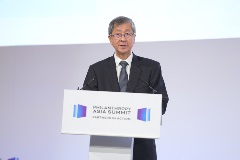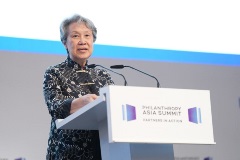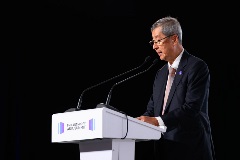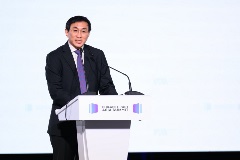Distinguished Guests,
Excellencies,
Ladies and Gentlemen,
A very warm welcome to the 4th Philanthropy Asia Summit.
Thank you for joining us from all over the world, in person and online, today.
Since 2021, PAS has served as a collaborative platform to catalyse multi-sector partnerships for impact. It has shown us what is possible when we act together, from showcasing game-changing solutions that can repair our planet and uplift communities, to featuring thought and action leaders who have mobilised cross-sector partnerships to deliver transformative impact.
This year, the joining forces of PAS and Temasek’s Ecosperity Week speak to the synergies of catalytic impact across the capital spectrum. Organisations focused on different parts of the capital spectrum – from commercial capital at one end, to philanthropic donations at the other – and all other forms in between, can connect and spark collaborations for good.
As shared by Seok Hui earlier, the evolution of PAS to now include partner events anchored by the Philanthropy Asia Alliance’s global programme partners will serve to spotlight solutions and systems thinking to amplify impact in the interconnected areas of climate, health, and education.
This cross-pollination of best practices is vital and must be strengthened, so we can learn and grow from our collective expertise, experiences, and build on what has already been achieved.
The growth of PAS as a global philanthropic platform with focus on Asia would not be possible without your strong support and partnership.
GROWING MOMENTUM OF CHANGE IN ASIA
There is a growing momentum of change in Asia. We know that solving for the global climate crisis must involve solving for Asia. Asia is a dynamic and diverse region that accounts for over half of the world’s emissions and 3 in 5 of its population.
Based on current trends, the Asia-Pacific will only meet 10% of the 118 measurable United Nations Sustainable Development Goal targets by 2030, unless efforts are rapidly multiplied.
Much more must be done, and quickly.
Yet, it is worth noting that the region has made significant strides towards a net-zero future.
As an example, China has led global renewable energy production for more than a decade. It is the top producer of solar panels and electric vehicle batteries worldwide. It accounts for more than half of the world’s installed wind and solar power.
By 2028, almost half of China’s electricity generation is forecast to come from renewable energy sources.
In India, the clean energy transition is well underway. Renewable electricity is growing at a faster rate in India than any other major economy and currently comprises about 44% of the country’s total installed capacity. It is also a major hub for wind energy manufacturing.
In Southeast Asia, Indonesia unveiled two major renewables projects last year – the region’s largest floating solar power plant, and the third largest worldwide, in West Java, as well as its first green hydrogen plant in Jakarta.
While we acknowledge that challenges do persist in the region, progress has been promising, and we must build on this positive momentum.
The urgency and scale of our challenges require that we shift from brown to green much faster. Only then would we have a chance to transition to a sustainable future for all, where no one is left behind.
NEED FOR SYSTEMS-LEVEL APPROACH
We will need, however, a systems-level approach.
The interconnectedness of climate with other crucial areas such as healthcare and education is well established. Effectively tackling these challenges will demand systems-level thinking and a holistic approach. Climate action must also address nature and other planetary boundaries.
Research has shown that planetary boundaries are at a breaking point, with the impact of human activity already extending beyond the safe operating space for four of the nine boundaries – biodiversity loss, chemical and plastic pollution, nutrient pollution, and greenhouse gas emissions.
This is unprecedented and we are in uncharted territory.
So, my message is this – We must act now, andwe must actboldly and tackle our challenges head on – together.
PARTNERSHIPS FOR IMPACT
This year’s PAS theme is “Partnerships for Action”. In the three Ps of Public-Private-Philanthropic partnerships we are advocating, philanthropy is the smallest ‘P’. But it is growing in importance as a partner for the other sectors to bring about sustainable change and development.
At COP28, the first Business & Philanthropy Climate Forum was convened over 1,200 private sector and philanthropic leaders coming together on the agenda of global climate and nature action. US$80 billion was committed to climate financing by countries, development banks, private sources, and philanthropists, including Singapore’s Financing Asia’s Transition Partnerships (FAST-P).
This is a heartening development, and we must do more.
Trillions in transition finance must be unlocked every year for us to get to net-zero. Asia alone, needs an estimated US$1.7 trillion in annual climate and infrastructure investments through to 2030. This can only be met by a combination of concessional and commercial capital.
While the philanthropic sector can provide catalytic capital to crowd in funding from the public and private sector capital, it is particularly vital for the private sector to step up. The private sector is where there is potential and capacity to mobilise substantial and sustainable financing, which are key to scaling solutions and accelerating the change we need. The International Monetary Fund has estimated that the private sector must supply about 80% of transition financing in the emerging economies which currently emit around two-thirds of greenhouse gases.
The scale of the climate challenge requires all hands on deck – everyone must do more. This is where multi-sector collaborative platforms come in. The PAA is one such platform. PAA is also a strategic partner to global platforms such as the Giving to Amplify Earth Action (GAEA) initiative by the World Economic Forum, which aims to catalyse Public-Private-Philanthropic Partnerships to unlock the trillions in annual financing for us to transition to net-zero.
Platforms and Alliances can only be as strong as the collective will and capabilities of their partners. All of us, with our respective strengths, resources, and expertise, must play our part.
PATHWAYS FOR COLLABORATIVE ACTION
There are many pathways for collaborative action. The COVID-19 pandemic mobilised global action in an unprecedented way. Climate change, which is the paramount challenge of our generation, certainly warrants the same, if not greater, urgency and resolve to act.
Since its launch, PAA has been working and innovating with its members and partners to convert the collective pledges from members, which now exceeds S$1 billion, through actionable commitments.
Noteworthy examples of such collaborative action and partnership include:
● piloting the PAA Communities initiative to mobilise collaboration for unlocking catalytic funding and galvanising urgent action in key focus areas;
● building capabilities and communities via the Asia Centre for Changemakers, that you’ll hear a little bit more about later;
● unveiling the first batch of Amplifier programme mentees to give aspiring impact innovators a fighting chance of survival;
● and partnering with Co-Axis, or the collaborative action to accelerate impact and sustainability – the acronym for Co-Axis – which is a digital catalytic capital marketplace which now has over 70 impact opportunities from more than 40 countries, where PAA members can take their pick of the opportunities available to attain their desired outcomes.
Whether you’re a funder, programme or knowledge partner, thank you for coming onboard and supporting PAA’s initiatives alongside other like-minded partners.
Together, we can prime Asia as a force for good.
WELCOMING PAA BOARD MEMBERS
Let me take this opportunity on behalf of Chairman PAA and also Chairman Temasek Trust to extend a warm welcome to PAA’s newly appointed Board Members – all prominent leaders from across the public, private, and philanthropic sectors.
Thank you for recognising the significant opportunity to drive impact in Asia and joining the PAA board to steer us towards delivering on this.
Your valuable insights, strong expertise, and extensive network and experience will guide PAA in forging new pathways for action in key emerging areas of impact.
Together with all our members and partners of the PAA, we look forward to working together to envision, strategise, and implement initiatives to close gaps and complement existing efforts within the wider philanthropic ecosystem, thereby advancing partnerships for action and impact across the public, private and philanthropic sectors.
CLOSING
Let me close with this simple message.
Multi-sector partnerships and concerted action today, will pave the way for a sustainable tomorrow.
Together, we can repair our planet, and forge a better and brighter future, so every generation prospers.
I wish everyone a most fruitful week ahead. Thank you.

.jpg?sfvrsn=28bcf165_1)


-(2).tmb-.jpg?Culture=en&sfvrsn=71ee5456_1)



.tmb-.jpg?Culture=en&sfvrsn=8f801359_1)
.tmb-.jpg?Culture=en&sfvrsn=abf428e0_1)


.tmb-.jpg?Culture=en&sfvrsn=6c4029d4_1)
.tmb-.png?Culture=en&sfvrsn=b8708911_1)

